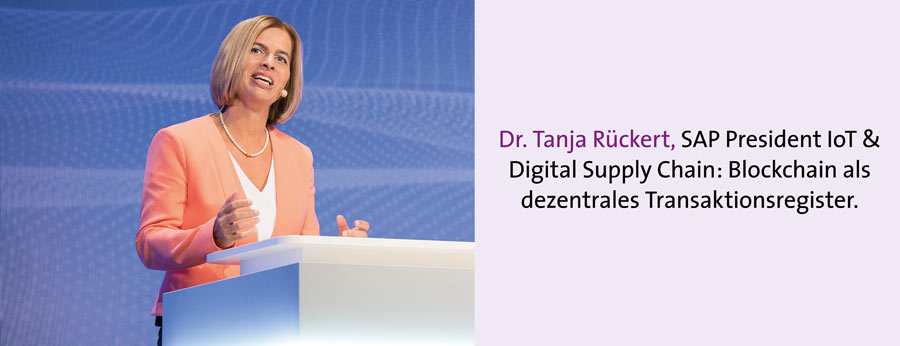Blockchain in focus


Blockchain in focusFor some, the blockchain boom is old wine in new bottles and others are waiting for disruptive applications. The fact is that blockchain can solve many tasks very elegantly and is generally available due to cloud computing and frameworks.
However, because blockchain technology promises very high security for the exchange of information, it is ideally suited for B2B scenarios and especially ERP environments. SAP partner Camelot was one of the first and is now one of the leading companies in the community to take an in-depth look at blockchain.
E-3 Editor-in-Chief Peter M. Färbinger spoke with Josef Packowski, CEO of Camelot Consulting Group, and Steffen Joswig, Managing Director at Camelot Innovative Technologies Lab (Camelot ITLab).
Hardly any technology has attracted as much attention in recent years as blockchain. Based on the soaring popularity of cryptocurrencies, more and more sectors outside the financial industry are examining the potential applications of this highly encrypted and thus secure distributed database technology.
Blockchain is a database system distributed over many nodes of a network - like the Internet - which is protected against manipulation by strong cryptography. The "network", in which the data is concatenated and encrypted, has another advantage: A data transaction can take place without intermediaries - and it is also forgery-proof!
Blockchain could change the way market participants in different industries transact with each other - and in the process, transform entire industries.
Whether in logistics and production or in the energy sector, numerous companies are testing possible applications: from direct electricity trading between neighbors to a transparently traceable supply chain.
The technology
The possibilities offered by blockchain technology provide an ideal basis for large networks with many different partners. They function in a similar way to a shared ledger and enable shared, unalterable records of all transactions that take place within this network.
Moreover, they allow the respective authorized partners to access the trusted data in real time. With the use of this technology, a completely new system of instructions and approvals can be introduced into the flow of information.
It allows the various trading partners to have a common view of the transaction that has been approved by all of them and, moreover, ensures trustworthiness and data protection.
Can blockchain technology be explained in a few words?
"An adequate explanation actually requires a few more words"
answers Steffen Joswig.
"Blockchain is a chained list in which each list entry (block) can comprise one or more data records. The chaining is done via cryptographic fingerprints, so-called hash entries.
Each hash entry is created from all records of a list entry. The hash entry is kept in both the preceding and following list entries. The list entries are thus immutably welded together, similar to a chain."

Smart Contracts
Furthermore, blockchain is a completely redundant data storage. All data is held by all participants in the network and is constantly synchronized.
"But the real bottom line is the programmability of the network via smart contracts"
emphasizes the Managing Director of Camelot Innovative Technologies Lab (Camelot ITLab).
A smart contract is a small program that is uploaded to the blockchain, where it is kept redundant and unchangeable, just like other data.
The interaction of smart contracts, data and events, i.e. predefined events, makes it possible to map certain processes in a tamper-proof and trustworthy manner, where middlemen have been used up to now.
Example:
IBM and Maersk, a global leader in container logistics, launched a collaboration in June 2016 to jointly develop new blockchain and cloud-based techniques.
These are designed to help companies track the path of their goods across international borders. Manufacturers, shipping companies, transport companies, ports, terminals and customs authorities can all benefit.
Blockchain is not equal to Bitcoin
"Bitcoin was the first, and today due to the speculative hype even the most media-savvy, implementation of a blockchain"
explains Josef Packowski, CEO of Camelot Consulting Group.
"However, this ignores the fact that blockchain is only one of many elements of the Bitcoin architecture. We keep emphasizing: blockchain is not Bitcoin."
So is blockchain a fad or a megatrend, because without blockchain confidential communication and data exchange will no longer be possible?
"Confidential communication and data sharing are possible even without blockchain"
Packowski emphasizes, and he explains:
"That doesn't make blockchain a megatrend. Concepts such as asymmetric encryption are an inherent part of blockchain, but it should not be reduced to that alone. The full potential of the technology is only realized when a blockchain network is used as a 'trust engine' to replace middlemen used today."
Steffen Joswig adds his experience from initial projects:
"However, to implement something like this, all the concepts of the blockchain, i.e. guaranteed authenticity of all participants, decentralization, immutability of data and secure program flows - smart contracts - must be applied equally.
In terms of this field of application, blockchain is indeed a megatrend that will soon become indispensable."
From the perspective of an existing SAP customer: In which applications could the use of blockchain based on ECC 6.0 and S/4 work?
"In the context of SAP systems, we initially see side-by-side extensions of existing SAP modules here in perspective."
Steffen Joswig is convinced.
"On a case-by-case basis, we now need to discuss which data from the SAP system should be meaningfully associated with the blockchain."
Without experienced partners like Camelot, such projects can hardly be implemented today, because a lot of business and technical knowledge is needed: As a rule, no data is stored redundantly on the blockchain, but rather registered there via cryptographic hash.
This approach ensures that the associated data in the SAP system cannot be changed unnoticed. This makes it possible, for example, to implement track & trace scenarios in the SAP SCM environment that are secured via blockchain or to implement cross-company transport marketplaces in SAP TM.
"However, these use cases typically only utilize individual blockchain features, such as immutable history"
Steffen Joswig describes the current situation.
"Really interesting use cases are those in which the blockchain mediates between multiple parties as a trust engine. Here, the SAP system and its database only act as so-called off-chain persistence, as the application logic generally has to take place in the aforementioned smart contracts in the absence of trust."
In addition to the new business processes, of course, the question of the infrastructure and hardware needed to apply blockchain is also important for SAP's existing customer.
"It depends on the deployment method chosen, which in turn depends heavily on the use case"
says Josef Packowski and passes the floor to his colleague Steffen Joswig:
"Publicly accessible blockchains are the most hardware-intensive, as a computationally intensive proof algorithm is used here, see Bitcoin and Ethereum. Consortium blockchains are different, however; here, a small Linux VM with manageable resources per blockchain node is already sufficient."
"We ourselves do not offer our own blockchain"
says Josef Packowski.
"There are many blockchain technologies on the market. However, their use usually turns out to be extremely complex. Our collective experience with blockchain technologies is bundled within the Camelot Hypertrust Platform."
Camelot has invested a great deal of resources in preparing blockchain technology, and this is benefiting the SAP community today.
"At the beginning of our research in this area, we decided not to simply document it, but to invest in a reusable framework"
Joswig explains.
"Using the framework, we can develop concrete blockchain use cases for customers in a very short time. In customer projects, we have then supplemented this with requirements from real-life use cases."
Setting up and operating common blockchains is complicated.
"You can't start developing distributed applications without hours of typing commands into dreary command lines"
Steffen Joswig knows from his operational environment.
And at Camelot, they asked themselves the questions:
- How can you simplify this process?
- How can we reduce implementation costs in blockchain projects?
- How can we enable customers to experiment with blockchains without a "hacker staff"?
- These questions were the birth of the Camelot Hypertrust Platform.
"It's hard to use a bare blockchain directly for application development"
emphasizes Josef Packowski. It's like a database without an application server, says his colleague Steffen Joswig, and he explains:
"For us, the middleware serves as a link between the blockchain, a user interface based on SAP UI5, and other services such as web services from the SAP Leonardo portfolio - IoT, AI, etc. - as well as a container for our blockchain applications. These consist in part of smart contracts and chain code inside the blockchain and server-side Java scripts outside the blockchain."
Also, the question arises: private or public blockchain? Josef Packowski:
"Depends on the use case. But within the context of value chains, we are usually talking about consortium blockchains - private network with clearly defined group of participants. Completely private blockchains are usually only needed for development."
Definitely, through initiatives such as those of Camelot and SAP Leonardo, the topic has arrived in the SAP community.
"Our customers and partners want to work with us and rely on blockchain as a decentralized transaction repository to improve collaboration and transparency"
Tanja Rückert, President IoT & Digital Supply Chain at SAP, said.
"The goal is a future where blockchain is an integral part of the digital value chain."
At SAP, for example, the Advanced Track and Trace for Pharmaceuticals pilot project has been developed. It can help pharmaceutical companies comply with regulations to protect against counterfeit drugs.
Through joint innovation with customers and partners, SAP aims to create use cases for blockchain that can be standardized and widely deployed - in logistics and in SAP Leonardo IoT solutions.
"What's interesting is that similar architectures have emerged here in a timely manner"
Josef Packowski currently analyzes the situation. The Camelot Hypertrust Platform was already introduced to customers in the first quarter of 2017 (at that time still Camelot Hypertrust Network).
"Then, when we saw the first beta version of SAP Blockchain-as-a-Service as a cloud version at the end of the second quarter, we were amazed at the similarity between the two stacks," Packowski says.
"Many of the components used occur both here and there. But the deployment model does make the two offerings quite different: SAP Blockchain-as-a-Service is only available in the cloud, while the Camelot Hypertrust Platform can fill the on-premise whitespace in the SAP context or, in principle, also be operated in the cloud."
And Steffen Joswig specifies:
"At first glance, it seems abstruse to rely on a trusted third party - cloud providers - with blockchain dealing with the elimination of trusted third parties. But the reality is that this is a software and hardware service that has its place in the blockchain environment.
Providing ready-made frameworks to facilitate the implementation of blockchain networks - whether now in the cloud or on customer premises - is a real value-add for business."
What the community needs is indeed a good mix. SAP customers will appreciate the Blockchain-as-a-Service service because of its simplicity, but their business partners and possibly non-SAP customers must not be excluded.
"Our services include many training offerings and workshops beyond consulting and technology."
Josef Packowski emphasizes in an E-3 interview, because he is aware of the existing knowledge deficit in the SAP community.
"From executive briefing workshops to blockchain developer and administrator training, we offer the right program for every level of business to understand blockchains, evaluate their potential and apply them.
Literature recommendation on technical level quite clear: ,Mastering Blockchain' and any publication by Vitalik Buterin."
Finally, Josef Packowski emphasizes the close cooperation between Camelot and SAP:
"We are partners with SAP in the Blockchain-as-a-Service and IoT Co-Innovation Program." Blockchain has definitely arrived in the SAP community!







